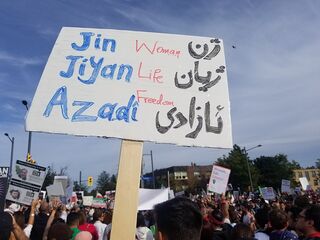Trauma
Trauma and Resilience in Young Iranians: What Do We Know?
When a regime unleashes its wrath on its youth.
Posted November 22, 2022 Reviewed by Gary Drevitch
Key points
- Detention, arrest, and torture of minors are reliably documented in Iran, and Children do not have a safe haven.
- Mental health professionals inside and outside of Iran need to prepare.
- Purpose and meaning can contribute to post-traumatic growth.

Over the last two months, the Islamic Republic of Iran has exerted aggression against its own people, with much of the violence directed against young women, male and female university students, and boys and girls of high school age.
How much do we know about what is happening in Iran today?
The regime is not transparent about the numbers and details of who is being arrested, wounded, and killed. It has sharply limited access to the internet and largely blocked journalists from first-hand access to demonstrations. NGOs and even local lawyers and health care professionals have limited access to detainees. With that, we do have some information about what is happening to minors.
Deaths of minors
In the first 40 days of the demonstration, Amnesty International documented at least 23 children killed. The ages ranged between 11 and 17. The causes of death include live ammunition, being shot with metal pellets, and beating. Since then, estimates of the number of children killed have risen to at least 33, according to Amnesty International, but other groups estimate 50 children or more have been killed.
"Iran’s security forces have killed nearly two dozen children in an attempt to crush the spirit of resistance among the country’s courageous youth. If the international community were a person, how would it look these children and their parents in the eye? It would lower its head in shame over its inaction against the pervasive impunity enjoyed by the Iranian authorities for their systematic crimes and gross violations of human rights" —Heba Morayef, Amnesty International, Regional Director for the Middle East and North Africa.
Arrest and detention of minors
Lawyers and human rights activists interviewed by The New York Times estimate that up to 1,000 children are in detention with many held in adult prisons, even though Iran's laws stipulate that minors may only be held in juvenile detention facilities.
Mental health abuse of detained minors
Children in detention have been subject to forced behavior therapy under the supervision of a psychologist and a cleric. The children are told that they have committed sins. In some instances, children who resisted behavioral treatment have been prescribed psychiatric drugs.
No safe refuge for children
Schools should be a sanctuary for children. In Iran, the regime has taken the battle directly to students in school. Police, plainclothes operatives (the Basij militia), and intelligence agents raid schools and interrogate, threaten, beat, and even kill students. The New York Times documented 23 raids on high schools alone.
In the city of Ardabil, the Basij militia stormed Shahed High School and beat students; 9 required hospital care, and a 15-year-old girl, Asra Panahi, was beaten to death, according to activists. (The government claimed that she committed suicide in captivity.)
In Shiraz, the principal of Amin Lari High School gave police surveillance footage to identify students involved in a protest in which students chanted slogans and smashed framed pictures of the Islamic Regime’s Supreme Leader, Ayatollah Ruhollah Khomeini. Sixteen students were suspended. In October, a Tehran elementary school was attacked because students were chanting anti-government slogans. Security forces threw tear gas in the yard during recess.
Basij militia operatives regularly confiscate or scrutinize the phones of students. Phones may be used to track communications between students, or between family members, invading another safe space for children.
In some documented cases, minors have just “disappeared” with no explanation to their families. Two teenage brothers have been missing for more than a month in Zahedan, for example, and a trio of 15-year-old girls disappeared in Lahijan.
Use of torture and indefinite detention under difficult conditions
The regime in Iran has made extensive use of torture (Busch et al., 2015) against adults since its founding. This includes psychological torture, electrical torture, beating, suspension, falanga, cigarette burns, and sexual torture. The protests received stimulus when female detainees were reportedly raped by police.
Even before the current round of protests that began in September 2022, prisoners of conscience, journalists, and protesters were detained arbitrarily on vaguely worded charges. Prisoners were regularly held in poor conditions and denied access to health care, according to the Annual Report of the United Nations High Commissioner for Human Rights.
There is reason to be concerned that minors detained in the current round of protests are subject to torture.
The impact of widespread violence and repression against minors
Speculation is always risky, and it is especially difficult in a country with extreme repression. Getting reliable data from inside Iran is difficult, and will remain difficult while the regime remains in control, but we do have some tools to predict outcomes.
A prominent article from 2021 found that political repression and torture in Iran contribute significantly to physical and mental health problems. (Mirzaei et al., 2021) An important factor is the baseline mental health condition of children and adolescents before the protests. Unfortunately, Iranian children may have had higher rates of anxiety disorders (social phobia and obsessive-compulsive disorder) than children in other countries in the region. (Zarafshan et al., 2015)
Ghahary (2003) found long-term persistent psychological consequences and psychosocial problems among Iranian adult political prisoners who were subject to torture. While it is difficult to extrapolate from an adult population to children, the findings are worrying. They include feeling that the general population did not understand them (a feeling experienced among activists who avoided imprisonment and torture as well), the prevalence of low self-esteem, loss of initiative, agraphobia, hypersensitivity, hypervigilance, and depression.
Psychosocial difficulties include problems functioning professionally, difficult relationships with spouses, inability to express emotions, unrealistic expectations of others, and fear of rejection.
Finding healing through purpose
Too many innocent people have been killed, detained, or tortured in Iran. Despite this, the protests have lasted for more than two months and continue as of this writing. The determination of many individuals, including minors and young adults, to resist the regime testifies to the meaning that the protestors give to their actions. This meaning provides resilience to the protestors, but it can also be an important factor in long-term recovery and post-traumatic growth.
Badiee (2015) describes an Iranian woman who was incarcerated for 9 years in a torture prison after participating in political protests. The study illustrates how finding purpose and connecting with a supportive community with a shared purpose can build resilience and aid in healing.
Preparing to support children and young people in and from Iran
Trauma is difficult, and complex trauma — the result of experiencing repeated traumatic events — even more so. Trauma can manifest as anxiety, depression, sleep disturbances, or unhealthy behaviors that persist even though the source of the trauma has long ceased to pose a threat.
Mental health professionals working with refugees from Iran, and mental health providers within Iran, need to be sensitive to hearing the stories of their clients and addressing their trauma.
© 2022 Dr. Fabiana Franco. All rights reserved.
References
Amnesty International (2022, October 13). Iran: At least 23 children killed with impunity during brutal crackdown on youthful protests. Retrieved November 15, 2022, from https://www.amnesty.org/en/latest/news/2022/10/iran-at-least-23-childre…
Busch J., Hansen S.H., Hougen H.P. Geographical distribution of torture: An.epidemiological study of torture reported by asylum applicants examined at the.Department of Forensic Medicine, University of Copenhagen. Torture 2015; 25:12-2
Badiee, M. (2015). Portrait of an Iranian woman torture survivor. Peace and Conflict: Journal of Peace Psychology, 21(3), 505.
Fassihi, F. (2022, November 14). Stymied by Protests, Iran Unleashes Its Wrath on Its Youth/ The New York Times. https://www.nytimes.com/2022/11/14/world/middleeast/iran-protests-child…
Ghahary, N. (2003). Sequelae of political torture: Narratives of trauma and resilience by Iranian torture survivors. https://scholarship.shu.edu/cgi/viewcontent.cgi?article=2429&context=di…
Mirzaei, S., Alizadeh, H., Zarei, S. Z., & Wenzel, T. (2021). Psychosocial consequences of widespread of torture and sociopolitical pressure in Iran. Social Medicine, 14(1), 37-43.
Situation of human rights in the Islamic Republic of Iran. Annual report of the United Nations High Commissioner for Human Rights and reports of the Office of the High Commissioner and the Secretary-General (A/HRC/40/24, Feb. 2019). United Nations-General Assembly 2019.
Zarafshan H, Mohammadi MR, Salmanian M. Prevalence of Anxiety Disorders among Children and Adolescents in Iran: A Systematic Review. Iran J Psychiatry 2015; 10:1-7.




